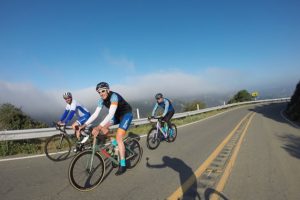A Wimp’s Guide to Climbing
 Richard Fries is the Director of Cycling Experience for the Best Buddies Challenges. With more than 40 years experience, he has been a racer, commuter, tourist, promoter, advocate, journalist and commentator on the sport and lifestyle of cycling. Having raced at the professional level both in America and Europe, Fries is well known as a race announcer having called countless USA Cycling National Championships, World Cups, and UCI World Championships. But he is also a tireless advocate having recently served as the executive director of MassBike. You can follow him on Strava to learn more.
Richard Fries is the Director of Cycling Experience for the Best Buddies Challenges. With more than 40 years experience, he has been a racer, commuter, tourist, promoter, advocate, journalist and commentator on the sport and lifestyle of cycling. Having raced at the professional level both in America and Europe, Fries is well known as a race announcer having called countless USA Cycling National Championships, World Cups, and UCI World Championships. But he is also a tireless advocate having recently served as the executive director of MassBike. You can follow him on Strava to learn more.
There’s no getting around it- you need to get over it. Climbing is hard.
So why do experienced cyclists actually seek out climbs? What could possibly be the attraction?
Climbing is where a cyclist truly distinguishes themselves in the sport, either going off the front or back. Climbing is the crucible that tests a rider’s real fitness. While an out-of-shape rider can draft in the pack, a hill or mountain will reveal every weakness, be it physical, mental or spiritual.
Here are some strategies and tactics to get you ready to hit the hill that will make a difference regardless of your level of fitness.
Five Before-Climb Tactics
- Recon the Climb. Even if you can only study the course map online- know when the climb starts, where the summit is, what are the grades, what are the landmarks worth noting. Even better is riding or driving the climb beforehand. And note that ironically sometimes climbs seem harder in a car than on the bike.
- Lighten the Load. Only bring what you absolutely need. Too many novice cyclists bring WAY too much stuff on bike rides. Strip your bike down to the essentials. Remember, the Challenge will have rest stops. Why travel with two full large water bottles that will add 1.5 lbs apiece to your burden? As you approach the climbs of our course, consider shedding extra clothing at the rest stops.
- Lighten Up the Gears. Make sure your bike has gearing that will allow you to spin-and not mash- the pedals on those extended climbs. For most riders, having a 36-tooth small chainring will work best.
- Go Hard Core. Strengthening your back and core make critical differences to your climbing. Yoga, gym work and even unconventional activities like juggling can help. Check out Nino Schurter’s Gym Workout on ways Olympic cyclists work on their core.
- Lose Weight. Dropping body weight makes the biggest difference by far. And, it’s a lot cheaper than spending thousands of dollars on a bike to save two pounds.
Five During-Climb Tactics
- Don’t Blow It. Set your pace at a level you can maintain, not at what the other riders are doing. Go too hard and you’ll blow like a fuse. Once you are at a sustainable pace, try to gauge for how long you can maintain that rate. This is what some folks refer to as the “hurt box” but it need not be so painful. Sure it’s tough! But, if you can sustain your pace for a considerable amount of time, you’ll simply get it done. If you can learn to climb efficiently, you can climb sizable mountains at a talking pace.
- Find Your Power Position. The positions you use on the flats or downhills are entirely different than how you sit on the bike for a climb. With low speed there is little concern for aerodynamics. Sit up, move your hands to the “tops” of the handlebars or the rubber brake hoods. Move your butt a little back, keep your chin up, and relax your shoulders.
- Scrape Mud. Instead of focusing entirely on the effort, focus on being as efficient as possible. Part of your “power position” is to focus on the pedal stroke. One tool is to think about pedaling through the bottom of the stroke, replicating the action of scraping mud off your shoes on the edge of a curb. You’ll be stunned how effective this makes your pedal stroke, especially when climbing in the saddle.
- Breathe. People too often forget to breathe. By this I mean deep, controlled breathing down into the belly with an emphasis on the out breath. Relax your upper body while keeping your chin up and shoulders back is also key.
- Mix It Up. Too many novice cyclists watch the Tour de France and try to replicate the climbing style of a 120-pound Spanish hummingbird by staying in the saddle. Normal people (as in people with a Body Mass Index above 10 percent) will want to mix it up and stand on the pedals.
- One trick is to shift up one cog heavier in rear wheel to stand and then shift back to a lighter cog when seated. The goal is not to go much harder when standing, but simply change the muscle groups and position. Many cite the legendary Alberto Contador for his style of climbing out of the saddle. You can learn about it here: Alberto Contador on Climbing.
Relax.
Try to get out regularly on a hilly route and simply ride the hills paying attention to your form and efficiency. Start out climbing slowly, but keep getting out on a hilly route regularly. If you pay attention to your times, you’ll likely notice the times come down steadily week after week. And so will your anxiety about climbing.
Relax, it’s just a hill.



